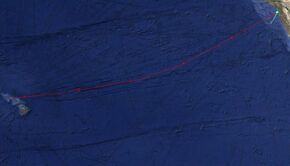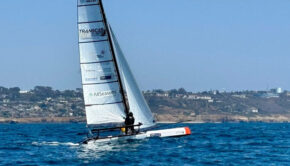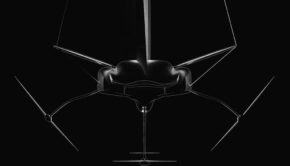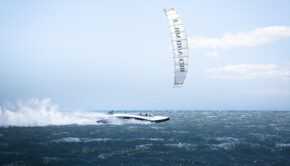Damage halts Jules Verne record attempt
Published on January 22nd, 2021
(January 22, 2021; Day 13) – The 32m Maxi Edmond de Rothschild, led by co-skippers Franck Cammas and Charles Caudrelier, have been forced to abandon their attempt to win the Jules Verne Trophy.
Sailing in the Indian Ocean since yesterday afternoon after their passage of the longitude of Cape Agulhas, the team was positioned at 48°28 south at 11:00 UTC with a lead of over 860 miles over the record when they informed their shore team of damage to the giant’s float rudder to starboard.
After a thorough inspection carried out by David Boileau, the boat captain, it was confirmed the appendage’s stock was seriously damaged, preventing the rudder to be used on that tack. With the six sailors unable to effect repairs in the open ocean as the part would need to be entirely replaced, the decision was made to interrupt its Jules Verne Trophy record attempt.
“Everything was going well aboard,” explained Caudrelier. “We were coming out of what was a tough night, with really heavy seas and a very shifty breeze, but things had improved since our gybe. Franck had just passed the helm to Morgan and a few minutes later there were some odd sensations and more and more vibration at the helm. We noticed that the leeward rudder, our starboard rudder, was moving around a lot from side to side.
“We brought the boat to a virtual standstill so David could go and look at the back of the float. Unfortunately, he quickly recognized that the rudder stock was seriously damaged. There was no particular impact to report prior to this observation and even though breakages are part and parcel of the history of our mechanical sport, we’re going to need to gain an understanding of what could have happened here.
“We cannot repair damage like this at sea and we can no longer use our rudder. We’ve raised it and now we’re sailing on port tack with no rudder. We are safe, but we are unable to go fast. The shore team and Marcel van Triest are looking at our options going forward, but one thing for sure is that the current health constraints related to the pandemic are complicating matters.
“We’ve turned back and we’re now setting a course towards Cape Town, which is around a two-day sea passage from here. In the meantime, we’ll decide whether we’re going to make a pit stop in South Africa or if we’ll make our own way straight back to Brittany.
“It’s a massive disappointment for everyone involved! We are so sorry to have to stop here, because we really wanted to bring this Jules Verne Trophy home… for Benjamin de Rothschild, Ariane de Rothschild, and all our team.
“We’ve had 12 fabulous days aboard with an incredible crew and the Maxi Edmond de Rothschild has really driven the point home that she is a truly exceptional boat.”
This was the team’s second effort this season, having abandoned a first attempt that lasted just three days in November 2020.
An effort led by Thomas Coville on the 32m trimaran Sodebo Ultim 3 to claim the Jules Verne Trophy also had to be abandoned due to damage to the starboard rudder. The team was on Day 17, sailing between the Kerguelen and Cape Leeuwin, when they had to stop on December 11, 2020.
While they had built a lead in the Atlantic of more than 600nm over record holder Idec Sport, the forecast in the Indian Ocean was far less favorable and the team lost miles on their advantage each day, falling behind the needed pace the day prior to their accident.
Position of the Maxi Edmond de Rothschild on 22 January at 12:58 UTC:
Speed: 20.7 knots
Course: 337°
Numbers to note:
• Passage across the line: 10 January 2021 at 01h 33′ 46” UTC
• Passage of the equator: 15 January 2021 at 14h 48’ 32’’ UTC, in 5 days 13 hours 14 minutes and 46 seconds
• Passage of the Cape of Good Hope: 21 January 2021 at 11h27’46’’ UTC, in 11 days 9 hours and 53 minutes (new reference time)
• Passage of Cape Agulhas: 21 January 2021 at 15h37’53’’ UTC, in 11 days 14 hours and 03 minutes (new reference time)
Team information – Tracker – Facebook
Since their start on January 10 at 01:33 UTC, to beat the round the world record of 40:23:30 set in 2017 by Francis Joyon and the crew of Idec Sport, they would have needed to finish prior to February 20 at 00:03:15 UTC.
Crew list:
Franck Cammas and Charles Caudrelier, skippers
David Boileau, trimmer/bowman
Erwan Israël, helm/trimmer
Morgan Lagravière, helm/trimmer
Yann Riou, trimmer/media man
Source: Gitana Team
The rules for the Jules Verne Trophy are simple – it is for the fastest time around the world by any type of yacht with no restrictions on the size of the crew, starting and finishing from the exact line between the Le Créac’h Lighthouse off the tip of Brittany and the Lizard Point in Cornwall. It was first won in 1993, with all nine winners as either catamarans or trimarans. The current challenge is to beat the record time of 40 days 23 hours 30 minutes and 30 seconds set by Francis Joyon and crew on the 31.5m IDEC Sport in 2017.
Record Facts
• Start and finish: a line between Créac’h lighthouse (Isle of Ushant) and Lizard Point (England)
• Course: non-stop around-the-world tour racing without outside assistance via the three Capes (Good Hope, Leeuwin and Horn)
• Minimum distance: 21,600 nautical miles (40,000 kilometres)
• Ratification: World Sailing Speed Record Council, www.sailspeedrecords.com
• Time to beat: 40 days, 23 hours, 30 minutes and 30 seconds
• Average speed: 21.96 knots
• Date of current record: January 2017
• Holder: IDEC SPORT, Francis Joyon and a 5-man crew
Split Time References – Full Crew:
Ushant-Equator: 4d 20h 07 ‘(Spindrift 2 in 2019)
Equator-Cape Aiguilles: 6d 08h 55 ‘(Banque Populaire V in 2012)
Cape Aiguilles-Cape Leeuwin: 4d 09h 32 ‘(IDEC Sport in 2017)
Cape Leuuwin-Cape Horn: 9d 08h 46 ‘(IDEC Sport in 2017)
Cape Horn-Equator: 7d 04h 27 ‘(Banque Populaire V in 2012)
Equator-Ushant: 5d 19h 21 ‘(IDEC Sport in 2017)
Here are the nine that have held the trophy:
2017 – Francis Joyon / IDEC SPORT (31.5m) – 40:23:30:30
2012 – Loïck Peyron / Banque Populaire V (40m) – 45:13:42:53
2010 – Franck Cammas / Groupama 3 (31.5m) – 48:07:44:52
2005 – Bruno Peyron / Orange II (36.8m) – 50:16:20:04
2004 – Olivier De Kersauson / Geronimo (33.8m) – 63:13:59:46
2002 – Bruno Peyron / Orange (32.8m) – 64:08:37:24
1997 – Olivier De Kersauson / Sport-Elec (27.3m) – 71:14:22:08
1994 – Peter Blake, Robin Knox-Johnston / Enza New Zealand (28m) – 74:22:17:22
1993 – Bruno Peyron / Commodore Explorer (28m) – 79:06:15:56









 We’ll keep your information safe.
We’ll keep your information safe.